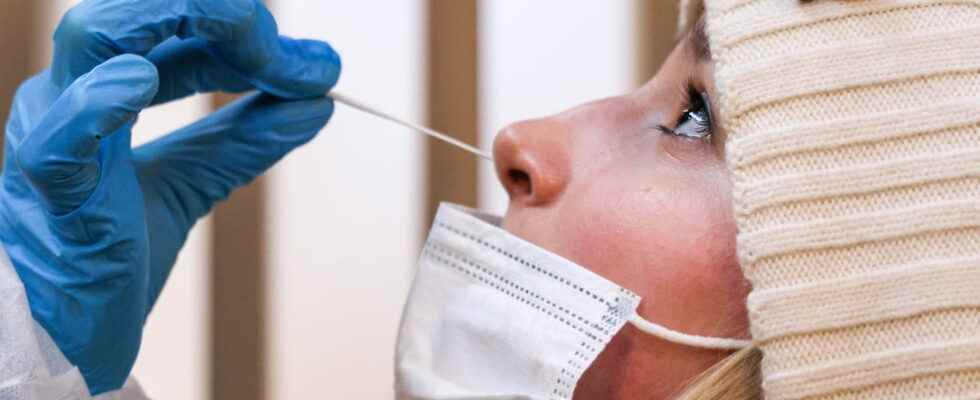COVID. The latest data, communicated by Public Health France, relating to the coronavirus epidemic in France have been encouraging for several weeks.
- The figures communicated by Public Health France therefore show that the number of new cases is decreasing day by day. In addition, the incidence rate has dropped in recent weeks. It is now 584 cases per 100,000 inhabitants. For more information on the figures relating to the coronavirus epidemic in France, you can consult our dedicated article.
- These are the first cases reported in the territory. Ten cases of the “Deltracon” hybrid variant have been identified in France, according to Public Health France and the National Reference Center for respiratory infection viruses (CNR). “Deltacron” results from the recombination between two variants: Delta and Omicron. According to Public Health France (SPF), the phenomenon of recombination is “frequent in Sars-Cov-2”. On its dangerousness, “it is difficult to predict what the characteristics of such a recombinant will be compared to the two parental variants and to anticipate its impact on public health.”
Learn more
According to last epidemiological point of Public Health France (SPF), published Thursday February 24, in week 07, “the circulation indicators of SARS-CoV-2 continued to improve, as did those of mortality linked to COVID-19, the whole indicators nevertheless remaining at a high level.”
- In mainland France, the incidence rate corrected decreases in all regions in week 07 (February 14-20, 2022), in comparison with week 6 (February 07-13, 2022): it falls below the threshold of 1,000 cases per 100,000 inhabitants, being 833 (i.e. -33% compared to the previous week, when the incidence rate was 1,371 positive cases per 100k inhabitants). This decrease was observed in all age groups and in all regions, notes SPF in its point. In addition, (3,505/100,000, -28%) and the positivity rate (23.8%, -4.4 points) continued to decline in all age groups.
- The effective reproduction rate of the virus, says R, also fell in week 07. It was evaluated at 0.57 (against 0.59 in W06). The test positivity rate was also down (23.8%, compared to 28.2% in S06, i.e. -4.4 points). This decrease was observed in all age groups; it was lowest among 80-89 year olds (16.9%, -1.9 points) and highest among 30-39 year olds (27.8%, -4.8 points).
- The number of new hospitalizations of Covid-19 patients fell in S07. The indicators by date of admission showed 8,891 new hospitalizations of patients with Covid-19 in week 07 (compared to 12,555 in S06, i.e. -29%). In addition, there were 1,066 new critical care admissions of Covid patients in S07, compared to 1,527 in S06 (i.e. -30%).
- The Omicron variant of the coronavirus is still the majority in France in S07, suspected and confirmed in 99.5% of Flash survey interpretable sequence screening tests in S06 (preliminary data). The BA.2 sublineage, a subvariant of the Omicron mutation, was still increasing (16% of cases in S06, 10% in S05 vs 5% in S04).
- Vaccination against Covid-19 is still progressing: as of February 22, 2022, 79.2% of the total population had received a full primary vaccination and 71.9% of those aged 18 and over had received a booster dose (82.1% among eligible people) and 82.6% among people aged 65 and over (90.9% among those eligible).
Follow the evolution of the coronavirus in your municipality thanks to the map below. Click on a department to display the list of municipalities. Also find all the details on this mapping and the complete point by city and by department in our article on the Covid map in France.
Since mid-October 2020, Public Health France has been communicating incidence data (number of cases per 100,000 inhabitants) at municipal level. The figures are at this stage communicated according to a scale (10, 20, 50, 150, 250, 500, 1000 cases per 100,000 inhabitants). The data is expressed over a rolling week, which means that it is calculated on a D-day from tests carried out between 3 and 9 days previously. To access information relating to the coronavirus in your municipality, enter its name in the search engine or click on its department in the map below.
As a reminder, the incidence rate corresponds to the number of new cases of Covid-19 over a period of one week, compared to the total population of a territory (country, region, department or municipality). This indicator is generally expressed as the number of cases per 100,000 inhabitants. The screening rate gives the number of people having carried out a screening test for the coronavirus out of the total number of inhabitants, during the period. It is also most often expressed per 100,000 inhabitants. Finally, the test positivity rate gives the percentage of positive tests for the coronavirus, compared to the total number of tests carried out over the period.
